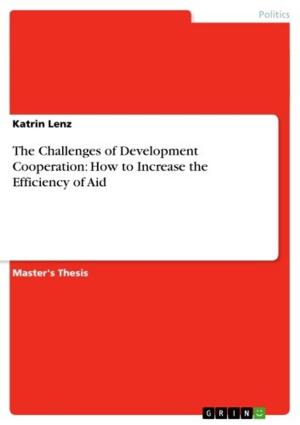Process Virtualization Theory in the Public Sector: A Scale Development Study
Nonfiction, Social & Cultural Studies, Political Science| Author: | Christian Lubasch | ISBN: | 9783656270676 |
| Publisher: | GRIN Publishing | Publication: | September 11, 2012 |
| Imprint: | GRIN Publishing | Language: | English |
| Author: | Christian Lubasch |
| ISBN: | 9783656270676 |
| Publisher: | GRIN Publishing |
| Publication: | September 11, 2012 |
| Imprint: | GRIN Publishing |
| Language: | English |
Diploma Thesis from the year 2011 in the subject Politics - Miscellaneous, grade: 1.0, University of Mannheim, course: E-Business & E-Government, language: English, abstract: The following diploma thesis is a scale development study in context of the public sector. A set of sound measurement models had to be developed for measuring an initially supplied, not yet quantitatively evaluated, conceptual model of Barth and Veit (2011). As the individual parts of the conceptual model are not of a directly observable nature, scale development techniques had to be used to make them empirically manifest (e.g. DeVellis, 2003; Gerbing and Anderson, 1988). A stringent procedure, based on literature recommendations and best practices was followed, as the development of reliable and valid scales is not trivial. There- fore, a generalized scale development procedure and its corresponding subparts were derived of a large amount of available publications from different fields of research like information systems, operations management, psychometrics, etc. Two specific processes of the public sector, namely the civil marriage and residency change, were used as context for phrasing meaningful sentences and cap- turing a broad range of citizens' resistance towards conducting a public process virtually. Eventually, the measurement models should be usable to easily apply the conceptual model to ideally any process of the public sector. After the creation of an initial pool of items, resulting preliminary scales were qualitatively tested and refined in multiple steps, ranging from expert opinions to comprehensiveness checks and particular sorting procedures. Notably, 62 distinct qualitative interviews with citizens were accomplished to reduce the set of indicators from 150 to 64. In a following step, a quantitative survey was employed, which yielded around 350 responses as a basis for data preparation and statistical analyses. This statistical evaluation procedure was twofold. First generation techniques like the exploratory factor analysis or Cronbach's Alpha were discussed and applied. Afterwards, the developed scales were tested in a confirmatory manner by the use of a multivariate second generation structural equation modeling approach. The two most common analysis methods for structural equation modeling, covariance-based via LISREL and variance-based via partial least squares, were compared, before the latter was applied due to theoretical considerations. Quality criteria of the measurement models were analyzed. As a result, all of these models comply to generally acknowledged evaluation criteria with regard to reliability and validity.
Diploma Thesis from the year 2011 in the subject Politics - Miscellaneous, grade: 1.0, University of Mannheim, course: E-Business & E-Government, language: English, abstract: The following diploma thesis is a scale development study in context of the public sector. A set of sound measurement models had to be developed for measuring an initially supplied, not yet quantitatively evaluated, conceptual model of Barth and Veit (2011). As the individual parts of the conceptual model are not of a directly observable nature, scale development techniques had to be used to make them empirically manifest (e.g. DeVellis, 2003; Gerbing and Anderson, 1988). A stringent procedure, based on literature recommendations and best practices was followed, as the development of reliable and valid scales is not trivial. There- fore, a generalized scale development procedure and its corresponding subparts were derived of a large amount of available publications from different fields of research like information systems, operations management, psychometrics, etc. Two specific processes of the public sector, namely the civil marriage and residency change, were used as context for phrasing meaningful sentences and cap- turing a broad range of citizens' resistance towards conducting a public process virtually. Eventually, the measurement models should be usable to easily apply the conceptual model to ideally any process of the public sector. After the creation of an initial pool of items, resulting preliminary scales were qualitatively tested and refined in multiple steps, ranging from expert opinions to comprehensiveness checks and particular sorting procedures. Notably, 62 distinct qualitative interviews with citizens were accomplished to reduce the set of indicators from 150 to 64. In a following step, a quantitative survey was employed, which yielded around 350 responses as a basis for data preparation and statistical analyses. This statistical evaluation procedure was twofold. First generation techniques like the exploratory factor analysis or Cronbach's Alpha were discussed and applied. Afterwards, the developed scales were tested in a confirmatory manner by the use of a multivariate second generation structural equation modeling approach. The two most common analysis methods for structural equation modeling, covariance-based via LISREL and variance-based via partial least squares, were compared, before the latter was applied due to theoretical considerations. Quality criteria of the measurement models were analyzed. As a result, all of these models comply to generally acknowledged evaluation criteria with regard to reliability and validity.















